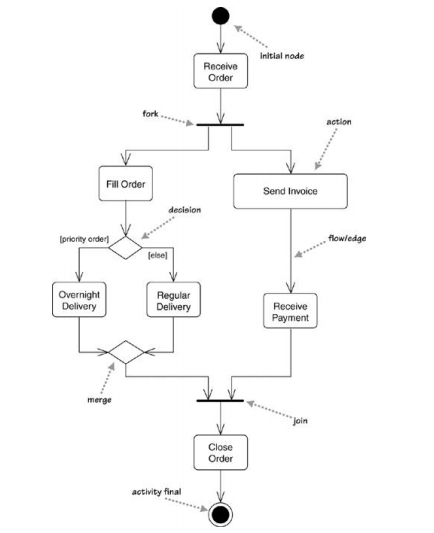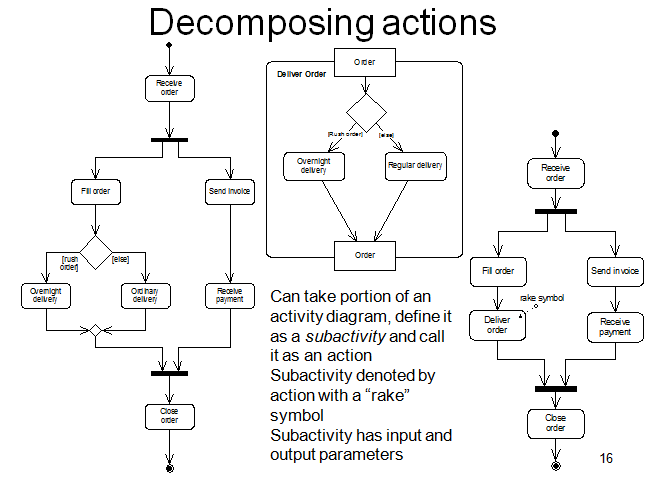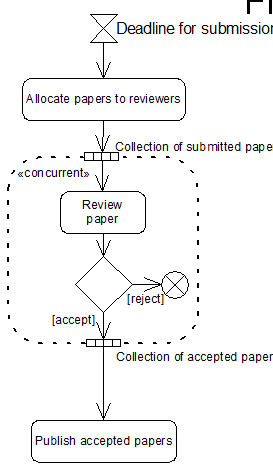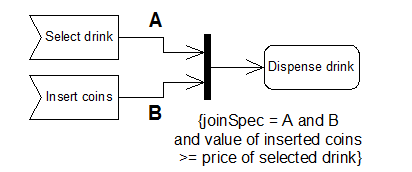
- •What is the uml?
- •2. What are ways of using uml
- •Describe uml diagrams.
- •4. How to fit the uml into development process?
- •Notes and comments, constraint rules, keywords on uml diagrams: definitions, description, examples.
- •6. Main elements of class diagram: definitions, description, examples.
- •7. Attributes and operations on class diagram: definitions,
- •Visibility name (parameter-list) : return-type {property-string}
- •8. Relationships between classes: definitions, description, examples.
- •9. Interfaces and abstract classes on class diagram:
- •10. Main elements of sequence diagram: definitions, description, examples.
- •11. Creating and deleting participants, synchronous and asynchronous calls on sequence diagram: definitions, description, examples.
- •12. Loops and conditionals on sequence diagram: definitions, description, examples.
- •13. Main elements of object diagram: definitions, description, examples.
- •14. Main elements of package diagram: definitions, description, examples.
- •15. How to show aspects on package diagram: definition, description, example.
- •16. Main elements of deployment diagram: definitions, description, examples.
- •17. Main elements of use case diagram: definitions, description, examples.
- •18. Levels of use cases on use case diagram: definitions, description, examples.
- •19. Relationships between use cases: definitions, description, examples.
- •20. Main elements of state machine diagram: definitions, description, examples.
- •21. Internal activities, activity states, superstates, concurrent states: definitions, description, examples.
- •22. Main elements of activity diagram: definitions, des, examples.
- •23. Decomposing an action on activity diagram: definition, description, example.
- •24. Partitions, expansion regions, flow final, join specifications: definitions, description, examples
- •25. Main elements of communication diagram: definitions, description, examples.
- •26. Composite structures: definition, description, example.
- •27. Main elements of component diagram: definitions, description, examples.
- •28. Collaborations: definition, description, example.
- •29. Main elements of interaction overview diagram: definitions, description, examples.
- •30. Main elements of timing diagram: definitions, description, examples.
- •Uml: Exam questions
- •What is the uml?
22. Main elements of activity diagram: definitions, des, examples.
Activity diagrams are a technique to describe procedural logic, business process, and work flow. In many ways, they play a role similar to flowcharts, but the principal difference between them and flowchart notation is that they support parallel behavior.
Initial node or start marker, activity final or stop marker (pseudostates). An action is something an object does, such as it sending a message
Action caused by an event can be recorded on transition after a forward slash
Guards- It may be the case that an event only causes a transition if certain conditions are satisfied
Conditions can be specified in a guard (e.g., [last copy], [not last copy], [x <= 3], etc.)
Guard expression can be any expression that has a boolean value (i.e., true or false)
In a guard, can use normal language, object constraint language (OCL), programming language – anything that allows for an unambiguous condition to be specified
Join merges two or more threads into one
Fork splits one thread into two or more concurrent threads
Trigger-event
Partitions (“swim lanes”)- Can use partitions or “swim lanes” to record the actions within the activity that are carried out by each
Class
Company department
Actor
User
Can also partition actions according to which use cases they belong to
Flows and edges- Flow or edge is arrow connecting actions in activity diagram
Simplest flow simply carries token
Can name flow if desired (but usually not necessary)
If awkward to connect two actions, can use connectors
Avoid connectors if possible!
Can pass objects along flows

23. Decomposing an action on activity diagram: definition, description, example.
Activity diagrams are a technique to describe procedural logic, business process, and work flow. In many ways, they play a role similar to flowcharts, but the principal difference between them and flowchart notation is that they support parallel behavior.
Figure 1 shows a simple example of an activity diagram. We begin at the initial node action and then do the action Receive Order. Once that is done, we encounter a fork. A fork has one incoming flow and several outgoing concurrent flows.

24. Partitions, expansion regions, flow final, join specifications: definitions, description, examples
Partitions (“swim lanes”)- Can use partitions or “swim lanes” to record the actions within the activity that are carried out by each
Class
Company department
Actor
User
…
Can also partition actions according to which use cases they belong to
Expansion regions
Flow finals- When have multiple tokens, flow can stop without activity stopping
Flow final indicates termination of flow, not activity
Time signal “Deadline for submission” triggers allocation of submitted papers to reviewers
Each paper is reviewed by a reviewer and either accepted or rejected
Reviewing done in parallel – indicated by keyword, <<concurrent>>
If paper rejected, ends flow; otherwise, token added to output collection
Output collection passed to “Publish accepted papers”
Expansion region acts as a filter

Use expansion regions when output of action triggers same sequence of actions to be performed on two or more objects

Join specifications- Join emits token on output flow when token arrived on each input flow
Sometimes want join to emit token when special conditions apply
Can do this with a join specification
Boolean expression must be true in order for token to be emitted on output flow

